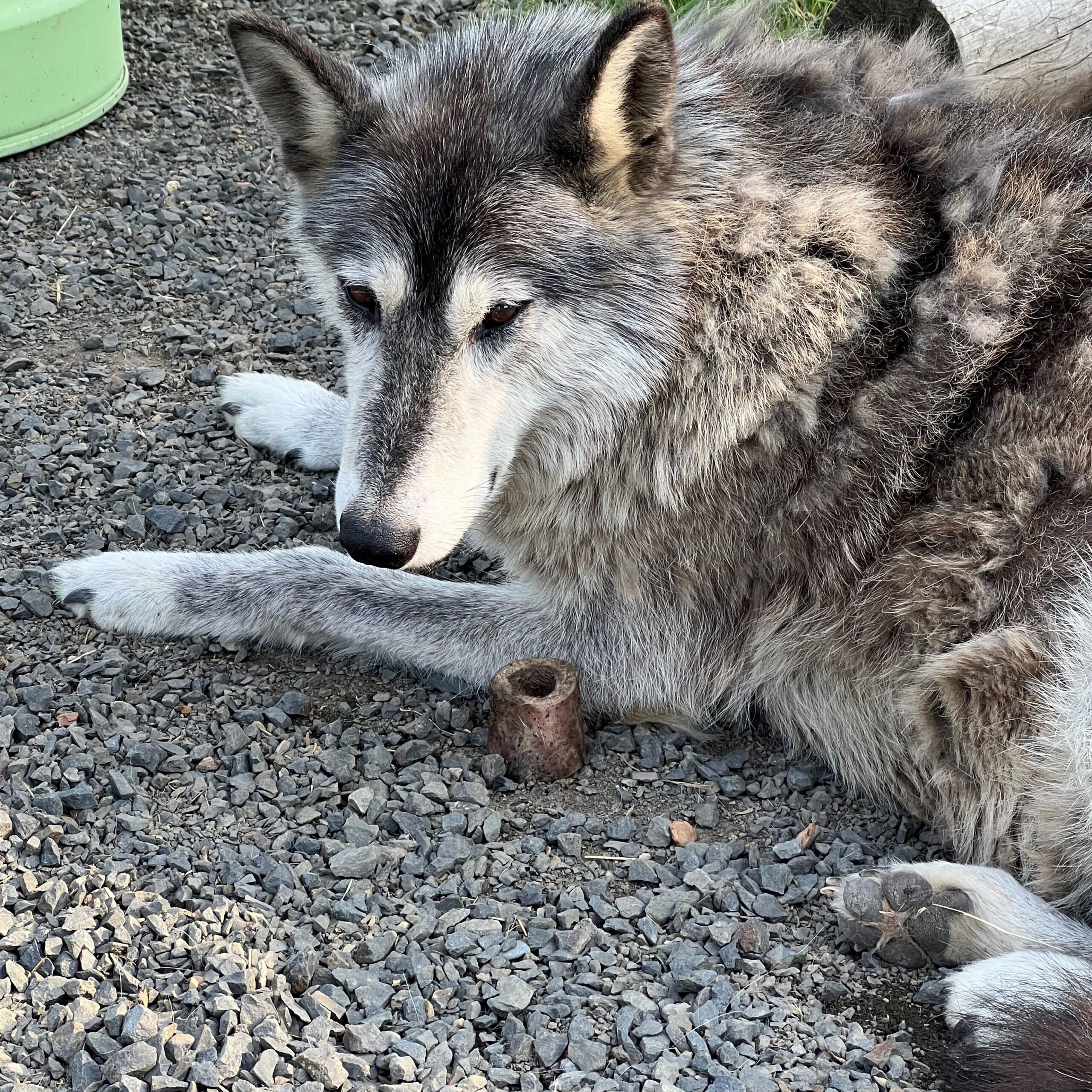Wolfdogs – Akeylah, Grae & Fancy
(Canis lupus × Canis familiaris)
Loyal. Mysterious. Misunderstood.
Neither fully wolf nor fully dog, the wolfdog (also known as a wolf hybrid) is a cross between a domestic dog and a gray wolf. With their striking eyes, keen intelligence, and independent nature, wolfdogs captivate the imagination—but also challenge human expectations.
While some individuals show dog-like friendliness, others retain the wariness and territorial instincts of their wild ancestors. This unpredictable mix makes wolfdogs unsuitable as pets, a fact often realized too late by those who acquire them.
At Cat Tales Wildlife Center, Akeylah, Grae, and Fancy serve as ambassadors for this complex and controversial hybrid—helping the public understand why wildness cannot be bred out and why responsible education, not ownership, is the true path to coexistence.



The Truth About Wolfdogs
Wolfdogs vary greatly depending on their genetics, upbringing, and environment. They are categorized as low-, mid-, or high-content, based on the percentage of wolf DNA they carry—but even a small amount of wolf ancestry can drastically alter behavior.
- Behavioral Challenges: Wolfdogs are instinct-driven and highly intelligent. They often dig, climb, or chew through enclosures that would easily contain domestic dogs.
- Unpredictable Temperament: Their responses to humans, training, or socialization can change suddenly, especially during maturity or breeding seasons.
- Legal Restrictions: Wolfdog ownership is illegal in at least 12 U.S. states and heavily regulated in 27 others, often requiring exotic animal permits, fencing standards, and inspections.
- Sanctuary Demand: Many wolfdogs are surrendered once they become unmanageable, creating a growing need for safe sanctuary homes like Cat Tales.
At Cat Tales, our wolfdogs live safely in spacious, natural habitats where their instincts are respected—and where their stories inspire compassion for all misunderstood predators.
- Species: Gray Wolf (Canis lupus)
- Range: Historically found across North America, Europe, and Asia; now limited by human expansion.
- Habitat: Arctic tundra, forests, plains, and mountainous regions.
- Social Life: Wolves live in packs—family units with complex communication, cooperation, and hierarchy.
- Communication: Their iconic howls serve as territorial markers and social calls, not threats.
- Ecological Role: As apex predators, wolves maintain ecosystem balance by controlling herbivore populations.
Though domesticated dogs descended from wolves thousands of years ago, wolves remain highly specialized hunters—instinctual, intelligent, and adapted to survive in the wild.
Meet Our Wolfdogs
Akeylah – The Sentinel
Born 2011, Akeylah came to Cat Tales in 2018 from a private owner in the Spokane area. She had lived much of her life chained outdoors, suffering from untreated wounds caused by her restraint and frequently escaping in search of freedom. Her owner, fearing she would be shot by neighbors, made the difficult but responsible decision to surrender her.
After months of treatment and rehabilitation, Akeylah settled into her new life at Cat Tales. Despite her calm appearance, she retains the instincts and strength of her wolf heritage—requiring experienced handling and protected contact. She patrols her enclosure daily, surveying her territory with sharp eyes and an alert posture that reminds every visitor: some spirits were never meant to be contained.
DNA: 28% Wolf, 22% Alaskan Malamute, 20% Siberian Husky, 8% German Shepherd, 7% Chow Chow
Grae – The Playful Spirit
Born June 13, 2015, Grae was bred at a wolf-hybrid rescue center in Oregon. By the time she reached her third home, her owner realized that even a mid-content wolfdog was not suited to suburban life. After visiting Cat Tales and learning about our Northwest Native Species exhibit, her owner requested placement for Grae where her wild nature could finally be understood and respected.
Grae is 50% gray wolf, giving her the long legs, piercing gaze, and powerful stride of her wild ancestors. Yet she’s also playful and social with familiar keepers, often vocalizing in greeting or chasing her favorite red soccer ball across her habitat. Her story demonstrates the fine balance between curiosity and caution that defines wolfdogs—and the importance of allowing instinct to thrive safely.
DNA: 50% Gray Wolf, 25% Siberian Husky, 12.5% Alaskan Malamute, 12.5% German Shepherd
Fancy – The Timid Wanderer
Fancy, born March 8, 2019, arrived at Cat Tales in May 2022 after being rehomed multiple times across the country—her fourth and final home. Like many hybrids, Fancy began life as an adorable puppy but soon “grew into her wolfiness,” displaying fear-based behaviors and independence that made her difficult to manage.
At Cat Tales, Fancy has begun rediscovering trust. She now lives beside Akeylah and Grae, where the sight, sound, and scent of other wolfdogs have helped her find comfort. Keepers approach her interactions on her terms—slowly, quietly, and with patience. Over time, Fancy has allowed limited tactile contact, a sign of progress that underscores the sanctuary’s philosophy: respect over control, understanding over dominance.
DNA: 29% Siberian Husky, 24% Alaskan Malamute, 17% Wolf, 11% Border Collie, 4% Chow Chow
Conservation & Education
While wolfdogs are not a wild species, they raise important questions about human-animal relationships and wildlife ethics. Many wolfdogs suffer due to misunderstanding—caught between the instincts of the wolf and the expectations placed on domestic pets.
By learning from Akeylah, Grae, and Fancy, visitors gain insight into:
- The importance of respecting wild genetics, even in hybrids
- The difference between rescue and ownership
- The need for stronger education and laws to prevent future breeding of wolfdogs for profit or novelty
These three ambassadors help shift public perception—from fascination to understanding, from fear to respect.
Life at Cat Tales
Our wolfdogs live in large, shaded habitats designed to encourage exploration, vocalization, and natural behaviors.
- Enrichment: Scents, frozen treats, and seasonal toys stimulate curiosity and play.
- Social Living: Akeylah, Grae, and Fancy communicate through howls, tail posture, and subtle body language—each reinforcing pack-style interaction without conflict.
- Protected Contact: Keepers maintain safe, trust-based relationships that honor each animal’s comfort zone.
Visitors often hear their haunting howls at dusk—a wild song that unites the voices of wolf and dog, echoing both the past and future of coexistence.


